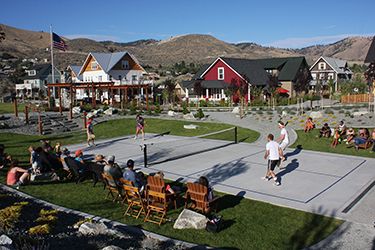| home | Welcome, sign in or click here to subscribe. | login |
DJC Subscriptions
Resource Center
DJC Services
Most Popular Stories
In Today's Public Notices
| FEATURED NOTICE | |
| City of the Dalles & Klickitat County South Apron Reconstruction New Taxilanes and New Fuel Apron | |
| New Bid Calls | 8 |
| New Consultant Notices | 2 |
| New Supply Bids | 2 |
New Sub Bids Requested
| SR 20 ET AL, NCR SEAL AND PAVING 2023 Granite Construction Company |
| ASA MERCER MIDDLE SCHOOL Betschart Mechanical, Inc. |
| S. 160TH ST LOT TNC IMPROVEMENTS PCL Construction Services, Inc. |
| UPS DISTRIBUTION CENTER • LYNNWOOD, WA Ferguson Construction |
| LYNNWOOD LINK EXTENSION – L230 – NE 130TH ST. INFILL STATION FINISHES Howard S. Wright |
| more » |
Real Estate
| |
 Nat Levy Real Estate Reporter |
November 6, 2014
Real Estate Buzz: New urbanism on the shores of Lake Chelan
Real Estate Reporter
The tug of war between cities and suburbs has gone on for decades, and right now cities are winning.
Suburbs prospered in the second half of the 20th Century, but now people are moving back into cities: companies, young people and empty nesters.
Even some second-home buyers want a more urban experience.
For a good example of this trend, check out The Lookout at Lake Chelan. Ted Schroth and Casey Roloff are part of a team of investors that paid $2 million in 2011 for land on the north shore of Lake Chelan. The two men are developing an 85-acre community there and it's all about pedestrians, not cars.
Schroth has developed mixed-use projects on Capitol Hill in Seattle, and Roloff developed Seabrook, a new community on the Washington coast near the town of Pacific Beach.
Schroth and Roloff say buyers don't want big garages or expansive yards. They want parks and other places where people can walk, gather, relax and play.
"We want people to park their cars and stay for the weekend, ride bikes or a golf cart, and really be on vacation and not be in a suburb situation where you are driving here and there, which is more typical," Roloff said.
So far it seems to be working.
Sales began in the summer of 2013 and 30 houses have sold at The Lookout. Prices range from $400,000s to the $800,000s.
When it is completed, The Lookout will have about 300 houses.
The Lookout is a mile from downtown Chelan, and will eventually connect to town with public trails for walking and cycling.
Second-home communities with walkable designs aren't really anything new. They were built for pedestrians before automobiles took over. Then the style shifted to suburban master-planned communities built around attractions like golf courses. During the recession a lot of second-home projects underperformed and changed hands, they said.
Roloff has done this already with Seabrook, which just had its 10th anniversary and 300th home sale.
Crews now are working on a "Main Street" at Seabrook, which will get up to 40,000 square feet of retail over a few years.
Seabrook eventually could have about 1,000 houses on 350 acres. Prices range from $350,000 to $3 million.
Roloff said Seabrook survived the recession — and sold 170 houses — while many other second home communities were "dying on the vine left and right."
Seabrook has become an established community with name recognition, but The Lookout is just getting started.
About $2 million has been spent on amenities at The Lookout such as an outdoor pool, clubhouse, central park, pickleball court, stone fireplace, outdoor barbecue and playground. Several small parks have also been completed.
A bike shop opened in July.
Construction has started on a 70-slip marina. Late next year, work will begin on a gym, indoor pool, spa and other year-round activities.
The Lookout was planned to have small pocket neighborhoods. Lots are released for sale a few at a time, and they are near each other. New sets of lots have different house designs to make them distinct.
Homes are built only after a lot is purchased.
"It really feels like a real community even though it is pretty small," Schroth said.
At The Lookout, Schroth and Roloff are seeing a mix of buyers, though most are retirees and young families with kids between the ages of 5 and 10. About 20 percent of the buyers are Chelan residents who want to live there full time. About half are from Eastside cities like Redmond, Sammamish, Issaquah and Kirkland.
Seabrook caters to a similar mix of buyers. Roloff said there are appealing aspects for a single person in his or her 20s as well as young families and retired people. Roloff said the goal is to create a diverse community through different types of houses and price points.
Here is the project team: Laurence Qamar of Qamar Architecture + Town Planning, Jerry Coburn of GCH, Kyle Gaffney and Russell Blazier of SkB Architects, Sam Nielson and Darren Sandeno of Parametrix, and Dave Harkey of Harkey Construction & Development.
What's up with real estate apps?
When they are planning a project, developers and architects have to sell lenders and tenants on their vision. Renderings have long been the tool of choice, but some developers are looking for ways to show more — both the flashy exterior and important functions inside — so they are using apps on smartphones and tablets.
This is keeping Studio 216 busy. Boaz Ashkenazy, founding partner at Studio 216, describes his Seattle-based company as a "boutique creative agency at the intersection of branding, technology and the digital experience of the built environment."
Ashkenazy said Studio 216 did its first app in the summer of 2013 for Skanska USA's 400 Fairview, an office project. Since then, Studio 216 has done apps for new office buildings, major renovations, apartments and even medical facilities.
Studio 216's most recent app is for Equity Residential's 40-story, 398-unit apartment tower at Second and Pine. Users can see panoramic views from every floor, including the rooftop deck. You can check out floor plans and maps of the surrounding area.
Each app has a few different features. For a commercial office building, you can see different floor layouts such as open plans with flexible workspaces for tech companies or more traditional layouts with personal offices.
On the app for a medical facility Studio 216 put in a feature that allows doctors and nurses to time how long it would take them to get from Point A to Point B — running or walking.
The next step, Ashkenazy said, is to make these apps more interactive, almost like a game where you can walk through a floor and customize things, give feedback and take snapshots along the way.
Got a tip? Contact DJC real estate editor Brian Miller at [email protected] or call him at (206) 219-6517.
Previous columns:
- Real Estate Buzz -- For sale: Prime spot on Bellevue Way, 10-30-2014
- Real Estate Buzz: Schnitzer leasing office hits the road, in an RV, 10-23-2014
- Real Estate Buzz -- For sale: about half of Yesler Terrace, 10-09-2014
- Real Estate Buzz: JLL report says some tech tenants are ready for big moves in Seattle, Bellevue, 10-02-2014
- Real Estate Buzz: At Mack Urban's Velo it's all about bikes, 09-25-2014
- Real Estate Buzz: Interior designers, contractors getting into whole a new field: the marijuana industry, 09-11-2014
- Real Estate Buzz -- Talk about mixed-use: Two theaters, retail, office, housing and parking for police cars, 09-04-2014
- Real Estate Buzz: As apartment rents soar in urban areas some people are rethinking the suburbs, 08-28-2014
MyDJC | Business | Construction | Real Estate | Architecture & Engineering | Environment | Machinery | Technology | Weekend
Copyright 2023 Seattle Daily Journal of Commerce | Terms of Service | Privacy Policy | Contact Us | Advertising | Site Index


